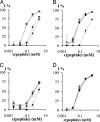Partial D-amino acid substitution: Improved enzymatic stability and preserved Ab recognition of a MUC2 epitope peptide
- PMID: 15630090
- PMCID: PMC544305
- DOI: 10.1073/pnas.0407677102
Partial D-amino acid substitution: Improved enzymatic stability and preserved Ab recognition of a MUC2 epitope peptide
Abstract
The stability of an immunogen against enzymatic degradation is considered an important factor for the design of synthetic vaccines. For our studies, we have selected an epitope from the tandem-repeat unit of the high-molecular-weight MUC2 mucin glycoprotein, which can be underglycosylated in case of colon cancer. In this study, we prepared a MUC2 peptide containing the PTGTQ epitope of a MUC2 protein backbone-specific mAb 996 and its derivatives. In these peptides, the N- and C-terminal flanking regions were systematically substituted by up to three d-amino acids. Peptides prepared by solid-phase synthesis were tested for their mAb 996 binding in competitive ELISA experiments, and their stability was studied in serum and lysosomal preparation. Our data show that the epitope function of peptide (15)TPTPTGTQTPT(25) is retained even in the presence of two d-amino acid residues at its N-terminal flanking region and up to three at its C-terminal flanking region (tpTPTGTQtpt). Also, this partly d peptide shows high resistance against proteolytic degradation in diluted human serum and in lysosomal preparation. These findings suggest that, by appropriate combination of structural modifications (namely, d-amino acid substitution) in the flanks of an Ab epitope, it is feasible to construct a synthetic antigen with preserved recognition properties and high stability against enzymatic degradation. Peptides tPTPTGTQTpt and tpTPTGTQTpt derived from this study can be used for immunization experiments and as potential components of synthetic vaccines for tumor therapy.
Figures



Similar articles
-
Solution structure of the all L- and D-amino acid-substituted mucin 2 epitope peptides.Biochem Biophys Res Commun. 2007 Jul 6;358(3):739-42. doi: 10.1016/j.bbrc.2007.04.200. Epub 2007 May 8. Biochem Biophys Res Commun. 2007. PMID: 17509526
-
Effect of D-amino acid substitution in a mucin 2 epitope on mucin-specific monoclonal antibody recognition.Arch Biochem Biophys. 2000 Jun 1;378(1):25-32. doi: 10.1006/abbi.2000.1801. Arch Biochem Biophys. 2000. PMID: 10871040
-
Localisation of a protein core-specific epitope from gastrointestinal mucin (MUC2). The effect of epitope immobilisation on antibody recognition.J Pept Sci. 1998 Aug;4(5):319-26. doi: 10.1002/(sici)1099-1387(199808)4:5<319::aid-psc151>3.0.co;2-1. J Pept Sci. 1998. PMID: 9753391
-
The MUC2 gene product: a human intestinal mucin.Int J Biochem Cell Biol. 1998 Jul;30(7):797-801. doi: 10.1016/s1357-2725(98)00028-4. Int J Biochem Cell Biol. 1998. PMID: 9722984 Review.
-
Diverse glycosylation of MUC1 and MUC2: potential significance in tumor immunity.J Biochem. 1999 Dec;126(6):975-85. doi: 10.1093/oxfordjournals.jbchem.a022565. J Biochem. 1999. PMID: 10578046 Review.
Cited by
-
Engineering the meso-diaminopimelate dehydrogenase from Symbiobacterium thermophilum by site saturation mutagenesis for D-phenylalanine synthesis.Appl Environ Microbiol. 2013 Aug;79(16):5078-81. doi: 10.1128/AEM.01049-13. Epub 2013 May 31. Appl Environ Microbiol. 2013. PMID: 23728814 Free PMC article.
-
Constrained Cyclic Peptides as Immunomodulatory Inhibitors of the CD2:CD58 Protein-Protein Interaction.ACS Chem Biol. 2016 Aug 19;11(8):2366-74. doi: 10.1021/acschembio.6b00486. Epub 2016 Jul 1. ACS Chem Biol. 2016. PMID: 27337048 Free PMC article.
-
Advancing d-amino acid-containing peptide discovery in the metazoan.Biochim Biophys Acta Proteins Proteom. 2021 Jan;1869(1):140553. doi: 10.1016/j.bbapap.2020.140553. Epub 2020 Sep 28. Biochim Biophys Acta Proteins Proteom. 2021. PMID: 33002629 Free PMC article. Review.
-
Development of a protease-resistant reporter to quantify BCR-ABL activity in intact cells.Analyst. 2016 Oct 17;141(21):6008-6017. doi: 10.1039/c6an01378c. Analyst. 2016. PMID: 27704073 Free PMC article.
-
Structural Motif Descriptors as a Way To Elucidate the Agonistic or Antagonistic Activity of Growth Hormone-Releasing Hormone Peptide Analogues.ACS Omega. 2018 Jul 6;3(7):7432-7440. doi: 10.1021/acsomega.8b00375. eCollection 2018 Jul 31. ACS Omega. 2018. PMID: 31458901 Free PMC article.
References
-
- Meyer, J. P., Gillespie, T. J., Hom, S., Hruby, V. J. & Davis, T. P. (1995) Peptides 16, 1215-1219. - PubMed
-
- Hudecz, F. (2001) Biologicals 29, 197-207. - PubMed
-
- Steer, D., Lew, R., Perlmutter, P., Smith, A. I. & Aguilar, M. I. (2002) Biochemistry 41, 10819-10826. - PubMed
-
- Hamamoto, K., Kida, Y., Zhang, Y., Shimizu, T. & Kuwano, K. (2002) Microbiol. Immunol. 46, 741-749. - PubMed
Publication types
MeSH terms
Substances
LinkOut - more resources
Full Text Sources
Other Literature Sources
Miscellaneous

